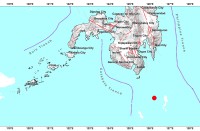(Eagle News) — The Philippine Institute of Volcanology and Seismology has lowered the alert status of Mayon Volcano.
The lowering from Alert Level 2 to Alert Level 1 means the volcano now has a low level of unrest, which means that the likelihood of an eruption occurring within the immediate future has decreased, PHIVOLCS said.
The move came after a continued decline in the monitored parameters of the volcano in Albay, even as ground deformation measurements on the volcano remain “anomalous.”
These include seismic activity, which went down to a daily average of one volcanic earthquake, and volcanic gas output, which has stabilized between 300-700 tons/day since January 2020.
According to PHIVOLCS, the latest flux was measured at 229 tons per day on June 30, “considerably below the baseline of 500 (tons/day).”
“The relatively low levels of SO2 flux indicate that passive degassing of stalled magma beneath the edifice has been transpiring,” PHIVOLCS said.
Steaming from the crater has also ranged from weak to moderate, with no significant changes in configuration to the lava-dome that occupies the crater, and only a faint crater glow.
“However, the lowering of the alert status should not be interpreted that the volcano’s unrest has ceased, considering that eruptible magma has already accumulated beneath the edifice,” PHIVOLCS warned.
PHIVOLCS said the public should still avoid entry into the 6-kilometer Permanent Danger Zone or PDZ due to “perennial hazards of rockfall, avalanche, ash puff and sudden steam-driven or phreatic eruption at the summit area.”
People living in valleys and active river channels were also told to remain vigilant against “sediment-laden streamflows and lahars” as a result of heavy rainfall during the rainy season.






